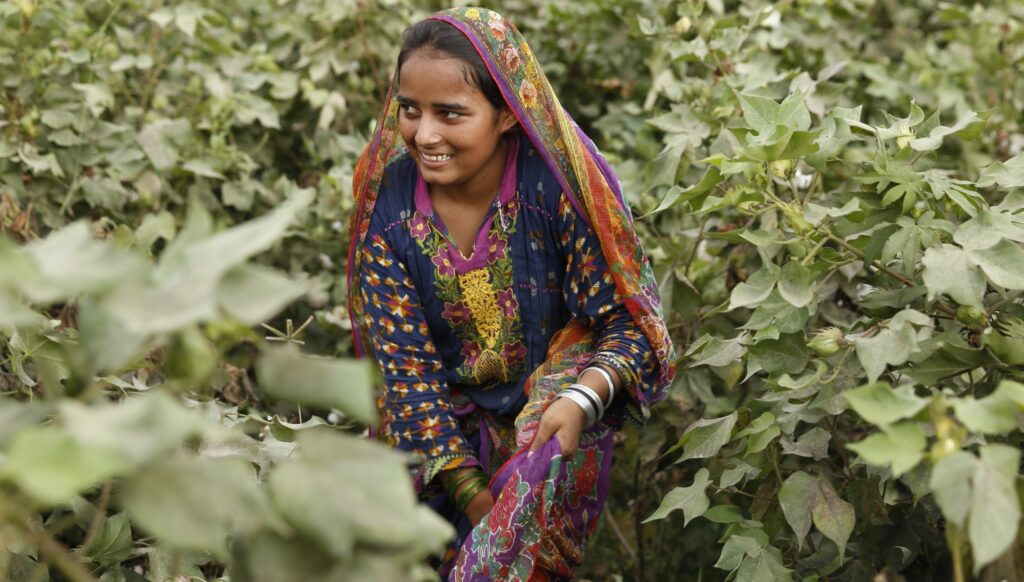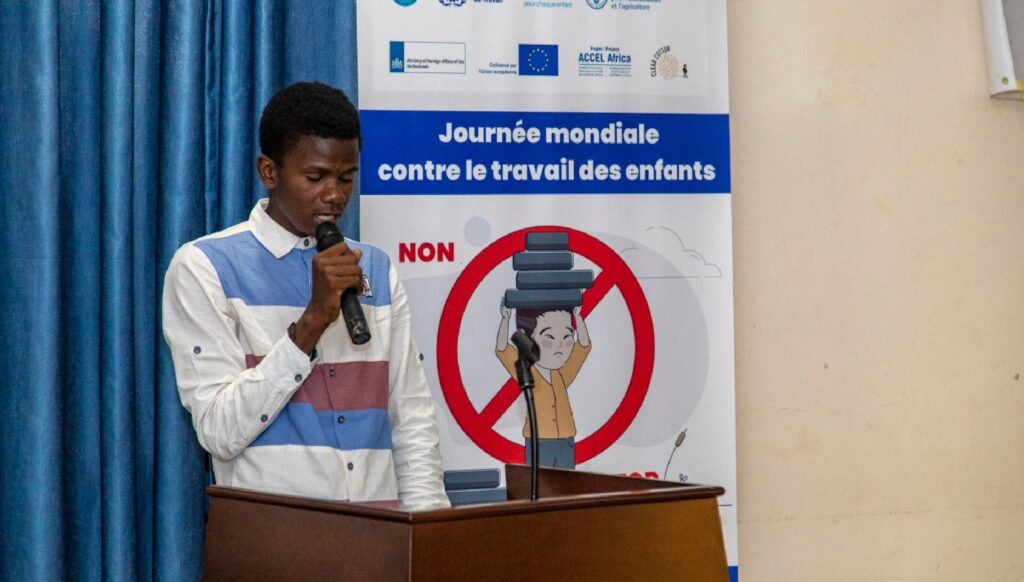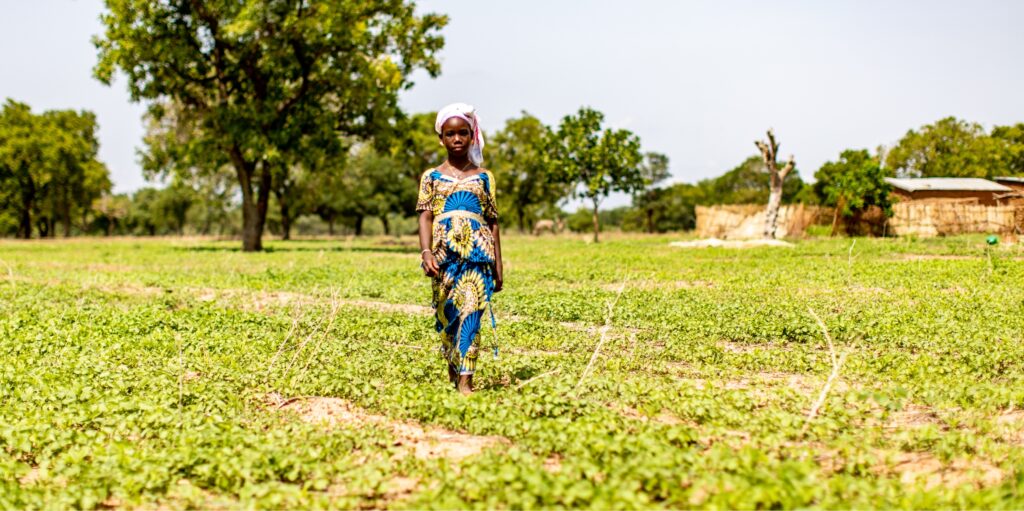FOREWORD
Cotton is one of the world’s most widely grown crops. Its production is heavily dependent on natural resources and labour. Unfortunately, child labour is often a part of this.
The CLEAR Cotton project was launched in 2018 to support the elimination of child labour and forced labour in the cotton, textile and garment value chains in four major cotton-producing countries: Burkina Faso, Mali, Pakistan, and Peru. The project was co-funded by the European Union and the International Labour Organization (ILO) and was implemented for a duration of five years by the ILO and the Food and Agriculture Organization (FAO). Its impact is being felt.
If we are to strive towards the UN Sustainable Development Goal (SDG) Target 8.7 to end child labour by 2025 and end forced labour, modern slavery and human trafficking by 2030, tackling these issues
in agriculture, including in the cotton sector, must be a crucial focus.

INTRODUCTION
An integrated approach to eliminating child labour and forced labour in the cotton, textile and garment value chains

SECTION 1
Eradicating child labour through stronger policy and legislation, and improved research
Strengthening national legislation and policies to combat child labour and forced labour is key to tackling these issues in the cotton, textile and garment sector. In a process driven by the governments in the project countries, National Action Plans were developed and implemented, bringing together ILO constituents and other concerned partners. Research
was also crucial, as a means to inform and drive action.

SECTION 2
Empowering stakeholders to fight child and forced labour in cotton-producing areas
The direct capacity building of stakeholders, including Ministries of Labour, public authorities, national employers’ and workers’ organizations, cooperatives and other actors reinforced their knowledge and ability to act to end child labour and forced labour in the cotton sector and their accountability in this regard.

SECTION 3
Providing educational opportunities as an alternative to child labour
Ensuring that all children have access to free, quality education is one of the measures that can make the biggest difference in the fight against child labour. Through the Accelerated Education Strategy, children were withdrawn from the cotton fields and provided with informal education as a bridge to reintegrating into the education system. Older children were provided with vocational training as a means to access to decent work opportunities in the future.

SECTION 4
Building resilience and supporting livelihood improvement in cotton-growing communities
Adults who have access to decent work and can support their families are less likely to resort to child labour. Empowering households, with a focus on women, improved families’ incomes which were reinvested in children’s education and well-being. Changing mindsets was also key, with Dimitra Clubs driving community-owned solutions.

SECTION 5
Prevention, protection and monitoring: Sustaining the impact
By establishing new monitoring mechanisms and strengthening existing ones, community members were actively involved in the identification, referral, protection
and prevention of children in or at risk of child labour.
Linking the monitoring activities to interventions on education and vocational training ensured that children who were withdrawn from child labour did not fall back into child labour.

SECTION 6
Raising awareness for a value chain free of child and forced labour
Building awareness on the risks of child labour and forced labour and the importance of education is key to tackling these issues. Once aware and empowered to act, stakeholders from all walks of life can contribute to the elimination of child labour. Raising awareness on hazardous child labour in agriculture ensured a shift to more sustainable and safe production practices.
Lessons learned
The CLEAR Cotton project was implemented in Burkina Faso, Mali, Pakistan and Peru for a duration of five years (from March 2018 to February 2023). The project was designed based on an integrated area-based approach with interventions along the value chain.
As the project progressed, whilst adapting to challenges such as the COVID-19 pandemic, the action evolved further, remaining participatory in its approach and involving a diverse range of stakeholders at all levels and with a lens on all Fundamental Principles and Rights at Work.
The following are a selection of overarching lessons learned across countries. More specific information on good practices and learnings at the country level can be found in the county-specific factsheets: Burkina Faso, Mali, Pakistan and Peru.
Applying an integrated area-based approach involves all concerned stakeholders and ensures that children withdrawn from child labour do not fall back into work.
The project intervened by involving the entire community at the village level in cotton-producing areas. Children in or at risk of child labour were withdrawn from these situations and provided with education or vocational training. Parents, in most instances mothers, were provided with support for Income Generating Activities (IGAs) and community leaders were provided with policy guidance and capacity-building opportunities. By addressing the needs of all community members and empowering them, the project addressed the different vulnerabilities, ensured that children who were withdrawn from child labour did not fall back into work, and importantly, mobilised the community around this issue.
Intervening along national cotton value chains mobilises actors from small-holder farmers to national companies and ensures sustainability and ownership.
The project intervened along national cotton value chains, supporting different stakeholders from small producers in the informal sector on family farms to companies in the ginning and spinning sector to national umbrella organisations. Formalising associations of cotton producers in cooperatives improved agricultural management and expertise which in turn boosted the income of cotton producers and helped ensure their children went to and stayed in school. Companies in the ginning and spinning sector were trained and, in Pakistan, a due diligence toolkit was developed for members of the Employers’ Federation of Pakistan (EFP). National cooperative federations were mobilised to abolish child and forced labour, apply the International Cooperative Alliance’s seven cooperative principles and ensure the respect of Fundamental Principles and Rights at Work.
Engaging ILO constituents and a diverse range of other stakeholders ensures a high level of commitment and accountability at all levels.
The project not only engaged traditional ILO constituents (Ministries of Labour, employers’ and workers’ organizations) but also reached out to a diverse range of other stakeholders. With the focus on agriculture, Ministries of Agriculture were actively involved, notably in developing Income Generating Activities (IGAs) with FAO support. The implementation of the Accelerated Schooling Strategy ensured the engagement of Ministries of Education. At local levels, a community-wide approach was adopted, working with civil society organizations (including youth-led associations) and village leaders amongst others, and those directly affected by child and forced labour. In this way, the project ensured a high level of commitment, wide ownership of the tools and results and cross-accountability at national and local levels.
Engaging communities from the onset through a participatory approach empowers them to take ownership and ultimately drive forward action.
Affected communities were involved from the very beginning of the project, at the design stage and in most activities. For example, the parents of children in or at risk of child labour participated in identifying children to benefit from schooling or vocational training. Through the community-level Child Labour Monitoring mechanisms established, actors at the village level now play a key role in identifying children in or at risk of child labour and referring them to the appropriate services. Communities were also involved in a large variety of awareness-raising interventions through the FAO-supported Dimitra Clubs and through activities on and around successive World Days Against Child Labour. By giving voice and agency to the communities, the project empowered them to make decisions about their own situation and take ownership. Community members have become agents of change as a result.
Promoting the respect of all Fundamental Principles and Rights at Work (FPRW) through an integrated approach is a means to tackle child and forced labour.
In addition to the focus on the abolition of child and forced labour, interventions aimed at ensuring respect for the three other Fundamental Principles and Rights at Work: Elimination of discrimination at work, Right to freedom of association and collective bargaining, and Right to a safe and healthy work environment. Occupational Safety and Health (OSH) was used as an entry point to tackle child labour with interventions on protecting children from exposure to pesticides and raising awareness of the dangers of pesticide use. This not only put a stop to hazardous child labour but also had a positive impact on parents’ health with income put towards education rather than medicine. Freedom of association and social dialogue were promoted as tools for producers to better negotiate cotton prices, have their concerns heard and addressed, and subsequently increase their income which allows them to afford adult labour. Concerning non-discrimination and gender equality, women were targeted as agents of change within their communities. Income-Generating Activities (IGAs) were specifically targeted at women which increased incomes and positively impacted the education of their children.
Adopting a collaborative approach across agencies and organizations leverages expertise and resources for joint and comprehensive action.
The ILO is the leading agency in the fight against child and forced labour with many years of action supporting its Member States to tackle these issues. FAO has expertise in rural development and addressing child labour in agriculture while the EU has the important capacity to trigger action and mobilise economic actors to respect Fundamental Principles and Rights at Work. By collaborating, ILO, FAO and the EU pooled their expertise, resources and tools and leveraged their networks to achieve a high level of delivery and efficiency. The EU delegations at the country level provided continuous support and guidance. The project’s implementing team, from ILO/FAO staff to national and local partners, worked hand-in-hand and with reactivity to ensure timely and coordinated delivery despite many challenges including the COVID-19 pandemic, security threats, coups d’état and climate crises. One good example of joint action to achieve impact is the coordinated approach with the ILO focus on the Accelerated Schooling Strategy. This ensured that children were withdrawn from child labour and reintegrated into school. FAO simultaneously supported livelihood interventions ensuring that parents were supported to improve their incomes and thus not resort to child labour in the future for lack of means to keep their children in school.
Reliable evidence and data on child labour in supply chains ensure that action and interventions are focused on where they are needed most.
At the beginning of the project, there was no reliable, recent and/or specific data on child labour or forced labour in the cotton supply chain either at the global, regional, national or local level. By producing such data at the country level, the project was able to assess the reality of the situation and target interventions to respond to the most salient and urgent needs using the most appropriate tools. For example, the project conducted a study on the needs of cotton cooperatives of Mali in terms of respecting and promoting Fundamental Principles and Rights at Work. The results showed there were no identifiable cases of forced labour in cotton production. Instead, there was limited knowledge of this issue and the indicators to identify it. As a result, the project’s direct interventions focused on addressing child labour whilst integrating specific training on forced labour. For example, the digital training on forced labour for managers of cotton cooperatives and companies.
Mainstreaming gender concerns promotes gender equality and maximises the impact of interventions.
The project mainstreamed gender concerns into activities from the design phase to implementation and evaluation. The project ensured that, to the extent possible, women participated in all activities, adapting as needed to different cultural contexts. For example, in Pakistan, where the practice is to separate women and men in educational settings, training for women cotton pickers on occupational safety and health, child labour and forced labour was provided for women only. The Income-Generating Activities (IGAs) targeting women validated the knowledge that improving the economic situation of women greatly improves the situation of the household, with regard to children’s education in particular. Women were also actively involved in the FAO-supported Dimitra Clubs, with specific clubs for women. Ultimately, empowering women helped, in turn, to empower the community, providing opportunities to rise out of poverty and ensure access to education.

CLEAR Cotton
The CLEAR Cotton project supports the elimination of child labour and forced labour in the cotton, textile and garment value chains in target producing countries (Burkina Faso, Mali, Pakistan, and Peru). It is co-funded by the European Union (EU) and the International Labour Organization (ILO), and it is implemented by the ILO in collaboration with the Food and Agriculture Organization (FAO).

